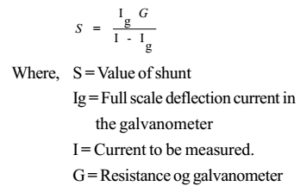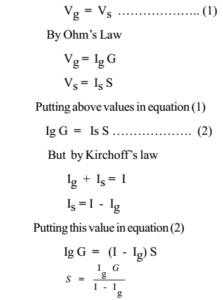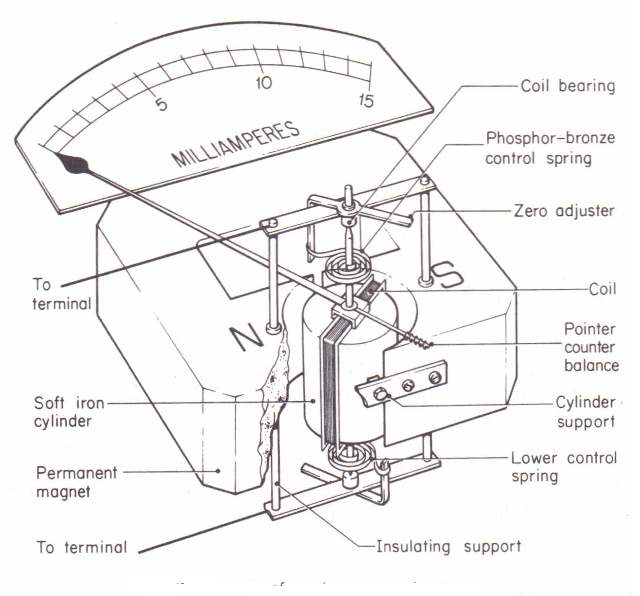Science > Physics > Magnetic Effect of Electric Current > Ammeter and Voltmeter
Ammeter:
An ammeter is an electrical measurement device (apparatus) which is used to measure the electric current in the electrical circuit.
Requirements of Good Ammeter:
- The resistance of an ammeter must be as small as possible. The ideal resistance of an ammeter should be zero.
- The ammeter should have a range sufficient for measuring a given current.
- It should be sufficiently sensitive (i.e. for a small change in current there should be a reasonable change in deflection).
- It should be direct reading.
Necessity of Shunting for an Ammeter:
We know that an ammeter is used for measuring current. It is to be connected in series in the circuit for this purpose. If the resistance of ammeter is not very low but considerable, then, when it is connected in a circuit the effective resistance of the circuit will considerably increase. Due to the increase in the value of the effective resistance of the circuit the current in the circuit will decrease compared to the original current in the circuit which was to be measured. Thus the decreased value of the current will be measured by the ammeter. In order to avoid this, the resistance of the ammeter should be very low. i.e. then the ammeter will be able to measure the current more accurately.
The effective resistance of the parallel combination is always smaller than the least value in the parallel combination. Hence a low-value resistance is connected in parallel across the galvanometer. This process is known as shunting.
Uses of a Shunt in an Ammeter:
- Due to the shunt, the effective resistance of the ammeter will be very low.
- Shunt increases the range of measurement of the current by the galvanometer and hence the range of ammeter is increased.
- Shunt protects the galvanometer coil from being damaged due to the excess flow of current.
Conversion of a Moving Coil Galvanometer into an Ammeter:
A sensitive moving coil galvanometer (pivoted type) is taken. To measure given the range of current a low resistance of suitable value is connected in parallel with it.

The scale is calibrated by comparison with a standard instrument.
Expression for the Value of a Shunt in an Ammeter:
Let G be the resistance of the galvanometer coil. Let Ig be the current required to give full-scale deflection in the galvanometer. Let S be the resistance to be connected in parallel with the galvanometer coil so as to measure a maximum current I. Let Is be the current through the shunt.

This is the expression for the low-value resistance which is to be connected in parallel with the galvanometer to convert it into an ammeter to measure the given current.
Voltmeter:
A voltmeter is an electrical measurement device (apparatus) which is used to measure the potential difference in the electrical circuit.
Requirements of Good Voltmeter :
- The resistance of a voltmeter must be as large as possible. The ideal resistance of an ammeter should be infinity.
- The voltmeter should have a range sufficient for measuring a given potential.
- It should be sufficiently sensitive (i.e. for a small change in voltage there should be a reasonable change in deflection).
- It should be direct reading.
Necessity of Connecting High-Value Resistance in a Voltmeter:
We know that a voltmeter is used to measure the potential difference between two points. (or across a resistance). It is to be connected in parallel for this purpose. If the resistance of the voltmeter is not very high it will divert a considerable current from the circuit through it, as a result, there will be a fall in potential difference. Instead of measuring the actual potential difference this decreased potential difference will be measured by the voltmeter. In order to avoid this the resistance of the voltmeter should be very high i.e. then the voltmeter will be able to measure the voltage more accurately.
We know that the effective resistance of the series combination is always larger than the largest value in the series combination. Hence a large value resistance connected in series with the galvanometer to convert it into the voltmeter.
Use of a High-Value Resistance in a Voltmeter:
- Due to the high-value resistance, the effective resistance of the voltmeter will be very high.
- High-value resistance increases the range of measurement of the potential difference by the galvanometer and hence the range of voltmeter is increased.
- High-value resistance protects the galvanometer coil from being damaged due to the excess voltage applied.
Conversion of a Moving Coil Galvanometer into a Voltmeter:
A sensitive moving coil galvanometer (pivoted type) is taken. To measure given the range of potential difference a high resistance of suitable value is connected in series with it.
The value of high-value resistance is given by

The scale is calibrated by comparison with a standard instrument.
Expression for Value of a Resistance in a Voltmeter:
Let G be the resistance of the galvanometer coil. Let Ig be the current required to give full-scale deflection in the galvanometer. Let R be the resistance to be connected in series with the galvanometer coil so as to measure a maximum potential difference V. Let Is be the current through the shunt.
Diagram:

This is the expression for the high-value resistance which is to be connected in series with galvanometer to convert it into a voltmeter to measure the given potential difference.
Distinguishing Between Ammeter and Voltmeter:
| Ammeter | Voltmeter |
| It is a moving coil galvanometer with a shunt i.e. low-value resistance in series with its coil. | It is a moving coil galvanometer with a high-value resistance in parallel with its coil. |
| Its resistance is low. | Its resistance is very high. |
| It is connected in series with the circuit. | It is connected in parallel with the component, across which the potential difference is to be measured. |
| The range of measurement of current can be changed by changing the shunt resistance. | The range of measurement of P.D. of voltmeter can be changed by changing the high-value resistance in the series. |
| To measure a larger current, a shunt of smaller value is required. | To measure a larger P.D. a larger resistance in series with galvanometer is required. |
Distinguishing Between Voltmeter and Potentiometer:
| Voltmeter | Potentiometer |
| Extremely low P.D. cannot be accurately measured with the help of a voltmeter. | It can be used for measuring low P.D. |
| It gives a direct reading. | It does not give a direct reading. |
| It is less sensitive. | It is very sensitive. |
Previous Topic: Moving Coil Galvanometer
Next Topic: Tangent Galvanometer
